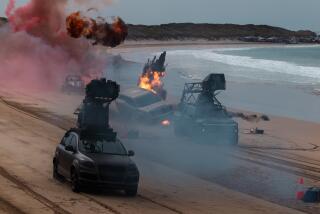A party crasher’s grand slam
Scott Weiss could barely suppress his panic. Perspiration glued his tuxedo shirt to his back. The forged all-access badge and tiny digital camera hung like weights around his neck as he approached the loading dock entrance.
The theater at Hollywood and Highland crawled with local cops, high-priced security guards and federal agents: FBI, sheriff’s deputies, LAPD bomb squad specialists and SWAT team snipers, all on high alert.
Weiss knew he could be charged with criminal trespassing -- if he got caught.
But there in broad daylight, at last year’s Oscars, while the eyes of the world were fixated on a massing constellation of stars on the red carpet, Weiss headed straight for the only entry point to the Academy Awards that did not have a computerized badge-checking device. A team of co-conspirators filmed Weiss’ every move from the balcony of a nearby apartment building.
Approaching the entrance, he pretended to be engrossed in a cellphone conversation. He carried two notebooks containing fake call sheets. In his head, the bearded, slightly portly party crasher ran through the spiel he had concocted to explain his presence. He was sure a guard would question him at some point.
In the summer of 2007, Weiss, a former actor who had a small part in “Robocop,” was regaling his longtime friend Ron Magid with stories from his glory days as a party crasher. He even had photos.
Weiss had paid $1,000 in the early 1990s to take a seminar in gate-crashing from a man who produced a public-access show called “The Party Crasher.” There, Weiss had mastered the art of sneaking into glitzy events to hobnob with the likes of Clint Eastwood, Courteney Cox and even Prince Charles.
“There were times I said to myself, ‘On the entire planet, this is the place to be,’ ” said Weiss, a 48-year-old West Los Angeles real estate appraiser. “Great food, exciting people. There is an exhilaration you get from doing this.”
But after four months, he decided to retire. “I moved on with my life,” Weiss said.
It was Magid, a freelance journalist who sells and trades rare movie memorabilia, who came up with the idea of filming Weiss in what they imagined would be a cinema verite comedy of an inept party crasher.
It would be “breaking into Hollywood so we could break into Hollywood,” said Magid, 48.
He enlisted director Larry Torro -- a freelance artist-filmmaker and former set painter for Warner Bros. who would only give his age as “in his 40s.” Magid had seen his feature film debut, “Jimmy 9 Lives,” at the Hollywood Film Festival in 2006.
The filmmakers hatched a plan to infiltrate all of Hollywood’s major awards shows. Weiss would be the face man. Magid and Torro would be his backup team. They would call the documentary “Crasher.”
They kept their expectations low. “We thought the movie was going to be 90% him getting turned away and getting humiliated,” said Magid, who has contributed freelance articles to The Times.
As a dry run, in July 2007, Weiss tried to crash a celebrity-packed party at the Geffen Contemporary museum that Tom Cruise threw for soccer superstar David Beckham. On his first attempt, Weiss was turned away by security. But by pretending to be a lost guest, he bluffed his way in and used a small camera to take “grab shots” -- photos of him mugging next to someone famous -- alongside Queen Latifah, Beckham and his wife, Spice Girls singer Victoria Beckham.
Weiss was now ready for his first major event -- the Emmys in September 2007. But this time, the filmmakers got organized. They outfitted a Chevy Suburban with party-crashing aids and props: wine glasses, a police scanner, colored paper for parking passes and clipboards, and a laptop computer and laminating machine to gin up fake badges.
Outside the Shrine Auditorium, Magid surreptitiously photographed one of the event’s production badges, and within 20 minutes Torro had Photoshopped a convincing fake in the SUV they had parked nearby.
With his necklace-cam recording his view of the caper, Weiss cruised into the auditorium and grabbed a seat. Later, at the event’s Governors Ball, he posed for grab shots with celebrities, including Sally Field, Hayden Panettiere and Stephen Colbert.
The photos serve as more than just souvenirs: They are proof of Weiss’ conquests.
The filmmakers began to believe there was no stopping them. Which is precisely why they got busted.
The next big event -- the Golden Globes -- wasn’t until January 2008. Doing reconnaissance, Weiss posed as a “Star Trek” convention organizer interested in renting the Beverly Hilton ballroom. That’s where the Globes would be announced at a news conference (the celebrity-studded show was canceled because of the Hollywood writers strike).
During a tour of the hotel, Weiss stumbled across a blueprint of the ballroom and photographed it. The filmmakers studied the schematics for potential entry points. Feeling that their plan to sneak in through the kitchen was foolproof, all three decided to crash. Ten minutes after entering the news conference, they were caught.
Weiss handed over his camera’s media card and Torro forfeited his camera’s tape; all three gave their driver’s license information to Beverly Hills police but were not arrested.
“It was absolutely terrifying,” Weiss said. “Luckily, we hadn’t gone to the effort to do much preparation. We didn’t forge a production pass. So we just looked like three idiots. That saved us.”
After the Golden Globes, the men knew that they had to be more careful. Weiss became the sole infiltrator, and had no problems crashing the Screen Actors Guild Awards in late January 2008 at the Shrine.
A month later, they stormed the Grammys, fashioning a crude access badge out of the gramophone logo from a pack of commemorative Grammys playing cards. Once again, Weiss breezed by security.
But heading into what they call the “Mt. Everest of party crashes” -- the Academy Awards -- the filmmakers weren’t sure they could pull it off. They assumed Globes producers had tipped off Oscars organizers about their stunt.
Nevertheless, Weiss began casing the Kodak Theatre. Taking digital photos of its back doors and alleyways, he familiarized himself with its entrances, looking for potential security weaknesses. He concluded that the theater was “like a suit of armor” with the rear end exposed. The loading dock entrance was his best bet.
They also decided that Weiss would play characters this time. Magid called it the Method-acting approach to crashing. They searched online photos of Academy Award nominees and came across Alexander Petrov, a Russian animation director whom Weiss vaguely resembled. Weiss then spent idle moments practicing a Russian accent.
“My back story was twofold,” Weiss recalled. “I was an assistant who had to run out to the car to get the call sheets and bring them to the show’s producer. But when I got backstage, I knew I had to get my badge off as soon as possible. Then my goal was to switch roles” to be the Russian nominee.
On the day of the show last February, Torro and Magid photographed an Oscars worker’s access badge to create a realistic-looking forgery on their laptop.
The next step was to secure a location from which they could film Weiss. Magid and Torro walked into the rental office of an apartment building directly behind the theater and asked whether they could rent a room for a few hours. Nothing was available, but the rental agent knocked on a tenant’s door. College students who lived there said Torro and Magid could film from the balcony.
Just before the show started, Weiss wandered up to the guards, fighting nerves, expecting to be stopped. He stayed in character as a producer’s assistant and walked right in, no questions asked.
But he wasn’t home free. Inside the Kodak, he had no idea where he was going and wandered the bowels of the theater, at one point brushing past Anne Hathaway near the green room.
The necklace-cam footage in the film shows Weiss nearly hyperventilating when an usher stops him at the door to an upper balcony. But she allows him in a moment later, and Weiss turns the camera around and films himself sitting happily in the audience during the ceremony.
After the show, brimming with false confidence, he tried to get into the Governors Ball but was turned away when he did not have the required lapel pin. He went to another floor and successfully ducked into the ballroom.
There, Weiss snapped grab shots with Oscar winners Javier Bardem and Daniel Day-Lewis and that year’s master of ceremonies, Jon Stewart. With that, he had accomplished what he calls the “grand slam of crashing” -- he had infiltrated some of the most glamorous events in town and capped it off by besting the tightest security in all of Hollywood.
Last week, the filmmakers provided a free consultation about potential security problems at the Kodak to the Academy of Motion Picture Arts and Sciences’ officials. The academy also arranged for every guard working the Oscars this Sunday to view “Crasher,” which the trio have yet to sell to a distributor.
“There is a distinct possibility that the publicity about these crashers -- as well as the video itself -- could serve as an inspiration or a road map for those looking to commit far more serious criminal acts,” academy communications director Leslie Unger said in a statement to The Times.
Weiss, Torro and Magid have met with a SAG Awards producer to discuss similar security issues. They have also offered their knowledge to producers of the Emmys, Grammys and Golden Globes.
“This is good for them to see all the things that could go wrong so it doesn’t happen when the bad guys are there,” Weiss said.
Now retired again from party crashing, Weiss said he would watch the Oscars from home Sunday. He was politely asked by the Academy Awards’ executive administrator not to crash the ceremony again. But he had no problem sharing the secret to sneaking behind the velvet rope.
“If you dress the part and put on an air that you belong there -- and that you don’t really have time to be stopped by anyone -- people are generally very polite,” Weiss said. “People in security don’t want to offend big shots. If you look like one, they won’t bother you.”
He added: “That’s the whole flaw in the system: the human touch.”
--
--
latimes.com
/columnone
Previous Column One articles are available online, along with ...
--
/oscars
... more photos and coverage of the Academy Awards.



